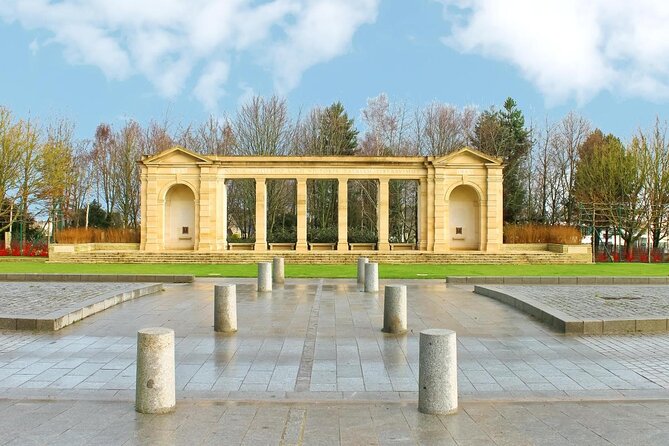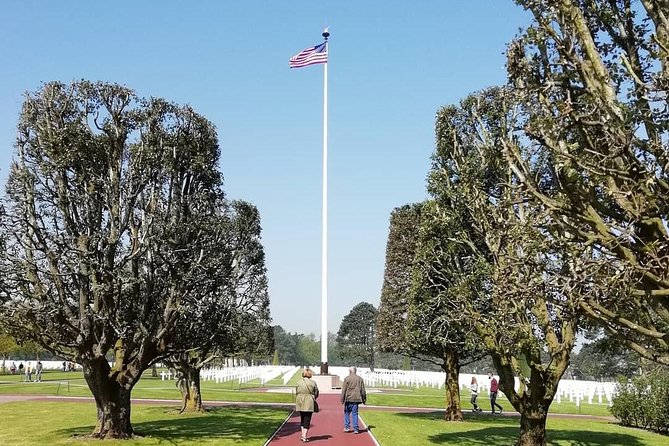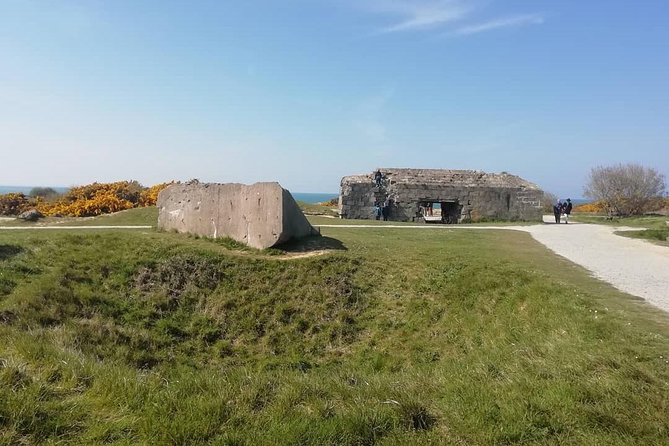Normandy’s D-Day beaches hold a profound significance, serving as hallowed ground where history unfolded on June 6, 1944. Exploring this storied landscape offers a chance to walk in the footsteps of the brave soldiers who fought for freedom. From the iconic Omaha Beach to the lesser-known Juno Beach, each site tells a unique tale of courage and sacrifice. Guided tours and memorials provide a deeply immersive experience, allowing visitors to fully grasp the magnitude of the Allied forces’ monumental efforts. Whether you’re a history buff or simply seek a meaningful travel experience, uncovering the secrets of the D-Day beaches promises to leave a lasting impact.
Good To Know

- Explore the five main D-Day invasion beaches – Utah, Omaha, Gold, Juno, and Sword – and learn about the pivotal role they played in the liberation of Western Europe.
- Visit poignant memorials and museums, like the Normandy American Cemetery and the Utah Beach Museum, to gain deeper insights into the courage and sacrifices of the Allied troops.
- Customize your itinerary to include significant sites, such as Pegasus Bridge, and benefit from the expertise of knowledgeable guides to enhance your understanding of the historic events.
- Plan your visit during the spring or early fall to avoid crowds and enjoy mild weather, which provides optimal lighting for captivating photography.
- Ensure accessibility and personalized attention through services like wheelchair-friendly facilities, audio devices, and flexible transportation options to make the most of your D-Day Beaches experience.
Overview of D-Day Significance
Why is the D-Day invasion in Normandy considered a significant turning point in World War II?
The Allied forces’ D-Day beach landings on June 6, 1944, marked the largest amphibious assault in history, with over 156,000 troops landing on five beach sectors.
This strategic operation enabled the liberation of Western Europe from Nazi occupation, a pivotal moment that shifted the course of the war.
The fierce battles resulted in over 10,000 casualties, underscoring the immense sacrifices made.
The Normandy campaign was crucial for the Allies, allowing them to establish a foothold in continental Europe and advance towards Germany, ultimately leading to the defeat of the Nazi regime.
You can also read our reviews of more tours and experiences in Rouen.
Key Normandy Invasion Beaches

On D-Day, the Allied forces landed on five main beaches in Normandy – Utah, Omaha, Gold, Juno, and Sword.
The American troops faced less resistance at Utah Beach, while Omaha saw heavy casualties and fierce German defense. British forces achieved successful landings at Gold Beach. Canadian troops made significant gains at Juno Beach. At Sword Beach, British forces linked with airborne troops.
Commemorative sites in the region include the Normandy American Cemetery, Pegasus Bridge Museum, Utah Beach Museum, Juno Beach Centre, and the Arromanches 360 Circular Cinema, which provide immersive D-Day experiences.
Commemorative Sites and Memorials

Dotting the Normandy landscape, a collection of powerful memorials and museums honor the sacrifices of D-Day.
Visitors can explore:
- The Normandy American Cemetery and Memorial, a solemn tribute to the fallen U.S. soldiers.
- Pegasus Bridge Museum, chronicling the daring airborne assault that secured a vital crossing.
- Utah Beach Museum, immersing guests in the historic landing and liberation.
- Juno Beach Centre, highlighting the pivotal role of Canadian troops on D-Day.
These hallowed sites provide a profound and moving experience, allowing visitors to reflect on the courage and sacrifice that paved the way for Europe’s liberation during World War II.
Transportation and Tour Options
Travelers to the D-Day beaches have several transportation and tour options to explore the historic sites.
Private car transportation is available from Paris or accommodations in Normandy, allowing for customizable itineraries that cover significant locations like Omaha Beach and Pointe du Hoc.
Tours include private transportation to all destinations, lunch provided during the tour, and personalized service tailored to group needs.
Exclusions include restaurant meals, souvenirs, and snacks, with comprehensive historical insights offered by knowledgeable guides.
Accessibility options are provided for various mobility needs, and public transport links connect major sites and towns, facilitating visitor access.
Best Time to Visit
The best time to visit the D-Day beaches is during spring and early fall. This prime visitation period offers mild weather, fewer crowds, and optimal conditions for exploring the historic sites.
Some key factors to consider when planning your visit include:
-
Comfortable Temperatures: Spring and early fall bring comfortable temperatures, typically ranging from 15-20°C (59-68°F), making it ideal for outdoor exploration.
-
Smaller Crowds: Avoiding the peak summer months allows you to navigate the sites with more ease and better appreciate the solemn atmosphere.
-
Optimal Lighting: The soft, diffused light of spring and early fall can provide stunning photographic opportunities across the Normandy landscape.
-
Fewer Closure Days: Many sites maintain regular operating hours during the shoulder seasons, ensuring a more seamless and accessible experience for visitors.
Enhancing the Learning Experience

Guided tours provide visitors with a deeper understanding of the D-Day beaches’ historical significance. Knowledgeable guides offer comprehensive insights, transporting guests back in time to the pivotal events of June 6, 1944.
Through their expert narration, the complexities of the Allied invasion and the ensuing battles come to life. Visitors gain a heightened appreciation for the sacrifices made and the strategic importance of the Normandy coastline.
These guided experiences enhance the learning journey, ensuring guests leave with a profound understanding of the D-Day legacy and its lasting impact on world history.
The personalized attention and tailored itineraries further elevate the overall experience for those seeking to fully enjoy this iconic chapter of World War II.
Accessibility and Accommodations
Accessibility options are provided for various mobility needs, catering to visitors with diverse requirements.
The D-Day beaches and surrounding sites offer the following:
-
Wheelchair-accessible pathways and facilities at popular landmarks like the Normandy American Cemetery and Memorial.
-
Guided tours with audio devices and translation services for those with hearing impairments.
-
Braille maps and tactile exhibits at museums, allowing visually impaired guests to explore the historical sites.
-
On-site medical assistance and disabled parking spaces to facilitate a comfortable and inclusive experience.
Local accommodations range from hotels to campsites, providing a variety of options to suit different budgets and preferences.
Pickup, Cancellation, and Policies
Flexible pickup points are available throughout Normandy, with specific details arranged upon request. Confirmation of the start time is required with the local provider. Child seats can be provided upon request, and the experience is exclusive to one group only, ensuring personalized attention.
| Cancellation Policy | Refund Amount |
|---|---|
| 24+ hours in advance | Full Refund |
| Less than 24 hours | No Refund |
A full refund is available for cancellations made 24 hours in advance, with clear guidelines provided for the cancellation procedures. Customer satisfaction is prioritized through flexible cancellation options.
Frequently Asked Questions
What Is the Dress Code for Visiting the D-Day Beaches?
There is no formal dress code for visiting the D-Day beaches. Comfortable, weather-appropriate clothing and sturdy walking shoes are recommended to fully explore the historical sites along the Normandy coastline.
Are There Any Age Restrictions for the Tour?
There are generally no age restrictions for the D-Day beach tours, though some activities may have minimum age requirements. Tour providers can accommodate families and travellers of all ages with appropriate safety measures and facilities.
Can I Take Photographs During the Tour?
Yes, visitors are welcome to take photographs during the D-Day beaches tour. The guides encourage guests to capture the historic sites and memorials, providing an immersive experience to remember the significance of the Normandy landings.
Are There Any Meal Options for Vegetarians or Those With Dietary Restrictions?
Yes, the tour providers accommodate vegetarians and those with dietary restrictions. Lunch options include vegetarian and gluten-free meals that can be requested when booking the tour.
What Type of Payment Methods Are Accepted for the Tour?
The tour providers accept a variety of payment methods, including credit cards, debit cards, and mobile payment apps. Guests can inquire about the specific options during the booking process to ensure a seamless payment experience.
The Sum Up
Discovering the D-Day beaches in Normandy offers an immersive and poignant experience. Visitors can explore the historic sites, pay tribute at memorials, and gain a deeper understanding of the Allied forces’ heroic efforts. With guided tours and accessible accommodations, the D-Day Beaches provide an enlightening and impactful journey through one of the most significant events in modern history.
More Tour Reviews in Rouen
- Rouen Scavenger Hunt and Sights Self-Guided Tour
- Official Rouen City Pass 24h, 48h, 72h
- Official English 2hrs Guided Tour of the Must-Sees of Rouen
- Walking Tour With an Actor-Guide: Rouen With Joan of Arc
- Rouen: Audio Guided City and Joan of Arc Tour
- The Official 1-Hour English Tour of the Must-Sees of Rouen
Not for you? Here's more nearby things to do in Rouen we have reviewed
- Official Rouen City Pass 24h, 48h, 72h
- Official English 2hrs Guided Tour of the Must-Sees of Rouen
- Walking Tour With an Actor-Guide: Rouen With Joan of Arc
- Rouen: Audio Guided City and Joan of Arc Tour
- The Official 1-Hour English Tour of the Must-Sees of Rouen
- Rouen: Get a Permanent Bracelet as an Eternal Souvenir !
- From Le Havre: Giverny and Rouen Shore Excursion
- Rouen: Immersive Viking Experience
- Rouen Gourmet Food Walking Tour Discover Normandys Flavors
- Treetop Adventure Course in the Heart of Rouen
- Rouen: Special Valentine’s Day Couples Game
- Rouen Pass 72h
